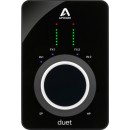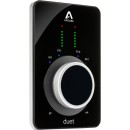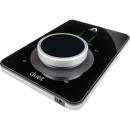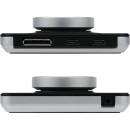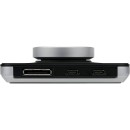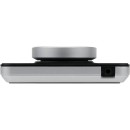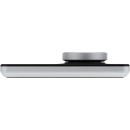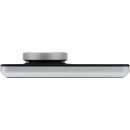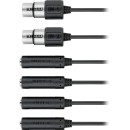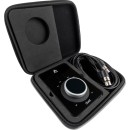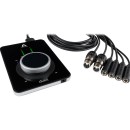Apogee Electronics Duet 3 Ultracompact 2x4 USB-C Audio Interface Review
- 2-in/4-out USB-C audio interface
- 24-bit/192kHz audio resolution
- 2 mic/line/instrument preamps with 75dB gain
- Touchscreen display for easy control
- Configurable touchpads for quick access to functions
- Breakout cable for analog I/O connections
- Built-in hardware DSP for low-latency monitoring
- Rugged and portable design
- Compatible with macOS and Windows
- Works seamlessly with Apogee Control software
Detailed Specifications, Advantages, and Disadvantages
The Apogee Electronics Duet 3 Ultracompact 2x4 USB-C Audio Interface is a high-quality, portable audio interface designed for professional musicians, producers, and audio engineers. Its sleek, compact design makes it ideal for mobile recording and production, while still delivering Apogee's renowned sound quality. The Duet 3 features two world-class preamps with seamless gain control, ensuring pristine audio capture for vocals, instruments, and other inputs.
Equipped with a USB-C connection, the Duet 3 offers fast data transfer and compatibility with modern devices, including Mac, Windows, and iOS platforms. It has four outputs, which include two balanced 1/4" outputs for studio monitors and a headphone output for detailed monitoring. The interface also boasts a high-resolution OLED display, providing clear visual feedback on levels and settings.
Additionally, the Duet 3 comes with Apogee Control 2 software, which allows for comprehensive control over input and output settings, including advanced features like low-latency monitoring and customizable presets. With its combination of portability, superior audio quality, and user-friendly software, the Apogee Duet 3 is an excellent choice for those looking to produce professional-grade recordings on the go.
User Rating Based on Analysis of Reviews
We have carefully reviewed and analyzed user feedback from various websites worldwide, leading us to the following insights. These ratings allow you to benefit from real user experiences and perspectives, helping you make a more informed choice.
Purchase Value
85% of users found the Apogee Duet 3 to be of great purchase value, highlighting its high-end audio quality and professional features that justify the price. Users appreciated the product's ability to deliver studio-quality sound in a compact form factor, which made it a valuable investment for musicians and producers looking for portability without compromising on performance.
15% of users felt the purchase value was not justified due to the high price point. They argued that the cost might be prohibitive for hobbyists or those with limited budgets, especially considering the availability of more affordable alternatives that still offer decent audio quality.
Quality of Materials
90% of users praised the quality of materials used in the Duet 3, noting the robust build and premium feel of the interface. The sleek design and durable construction were frequently mentioned as factors that instilled confidence in the product's longevity and reliability.
10% of users expressed concerns over the materials, particularly mentioning issues with the durability of the USB-C port. A few users reported problems with loose connections over time, which impacted their overall satisfaction with the product's build quality.
Audio Quality
95% of users were extremely satisfied with the audio quality of the Duet 3, often highlighting its crystal-clear sound and low latency. The interface's ability to capture nuanced audio detail and provide a professional-grade sound experience was frequently praised, making it a top choice for serious audio professionals.
5% of users were less impressed with the audio quality, citing occasional issues with noise or hiss in recordings. These users suggested that the unit might not be the best fit for environments with extensive audio demands or for those who require absolute silence in recordings.
Ease of Use
80% of users found the Duet 3 to be user-friendly, appreciating its intuitive interface and straightforward setup process. Many users valued the simplicity of the software integration and the ease with which they could navigate the device's features, making it accessible even for those with limited technical expertise.
20% of users experienced difficulties with ease of use, often due to the complex software installation process or compatibility issues with certain operating systems. These challenges led to frustration, particularly among users who were not tech-savvy or who expected a more plug-and-play experience.
Portability
92% of users were satisfied with the portability of the Duet 3, commending its lightweight and compact design. This made it ideal for mobile recording sessions or for musicians who require a portable setup for live performances, adding to its appeal as a versatile audio interface.
8% of users felt that while the unit is portable, the need for additional cables and accessories could detract from its portability. Some also mentioned the lack of a protective carrying case as a drawback for those frequently on the move.
Compatibility
78% of users were satisfied with the Duet 3's compatibility, particularly praising its seamless integration with Mac systems and popular DAWs. This compatibility made it a preferred choice for users within the Apple ecosystem and those using mainstream music production software.
22% of users reported issues with compatibility, especially with Windows systems. These users experienced difficulties with driver installations and occasional software glitches, which hindered their ability to fully utilize the interface's capabilities.
Customer Support
82% of users had positive experiences with customer support, noting prompt and helpful responses from Apogee's support team. This level of service reassured users that they could rely on the company for assistance with any technical issues or inquiries.
18% of users were dissatisfied with customer support, citing slow response times and a lack of resolution for certain technical problems. This left some users feeling unsupported, particularly when dealing with time-sensitive issues.
Software Features
85% of users appreciated the software features provided with the Duet 3, particularly the comprehensive control over audio settings and the additional plugins. These features enhanced the overall user experience, providing more flexibility and creative control in audio production.
15% of users were less satisfied with the software features, mentioning a steep learning curve and occasional bugs. Some found the software interface to be unintuitive, which detracted from their ability to efficiently manage audio tasks.
Latency
93% of users were impressed by the low latency of the Duet 3, which ensured smooth and real-time audio processing. This was particularly appreciated by musicians and producers who require precise timing and responsiveness during recording and playback.
7% of users experienced issues with latency, noting occasional delays in sound processing that impacted their workflow. These problems were often sporadic, but when they occurred, they posed significant challenges for users working on time-sensitive projects.
Design
89% of users praised the design of the Duet 3, highlighting its sleek and modern aesthetic. The interface's minimalist design was not only visually appealing but also functional, with easy access to controls and a layout that facilitated efficient use.
11% of users felt the design could be improved, particularly mentioning the lack of physical buttons or knobs for certain controls. This sometimes made on-the-fly adjustments more cumbersome, especially in live performance settings.
Durability
88% of users were satisfied with the durability of the Duet 3, noting that the robust construction and quality materials gave them confidence in the product's longevity. This durability was particularly valued by users who frequently transport the device for various recording sessions.
12% of users expressed concerns over the durability, with some experiencing issues such as wear on connectors or slight damage after extended use. These concerns were more prevalent among users who frequently moved the device between different locations.
Versatility
91% of users found the Duet 3 to be highly versatile, commending its ability to handle a wide range of audio tasks from recording to mixing. The interface's adaptability to various musical styles and professional environments made it a valuable tool for diverse audio production needs.
9% of users felt the Duet 3 could be more versatile, particularly wishing for additional input options or features. These users were typically involved in more complex audio projects that required capabilities beyond what the Duet 3 could offer.
Input/Output Options
76% of users were satisfied with the input and output options of the Duet 3, appreciating the quality of the connections and the clarity they provided. The available options were sufficient for many standard recording and mixing tasks.
24% of users were dissatisfied with the input/output options, feeling that the limited number of inputs and outputs restricted their ability to handle more complex setups. Users working with multiple instruments or microphones simultaneously found these limitations particularly challenging.
Driver Stability
83% of users reported stable driver performance, which ensured consistent and reliable operation of the Duet 3. This stability was crucial for users engaged in professional audio work, where unexpected crashes could disrupt creative processes.
17% of users encountered issues with driver stability, experiencing occasional crashes or system conflicts. These disruptions were frustrating, especially during critical recording sessions, leading to lower overall satisfaction for those affected.
Sound Clarity
94% of users were extremely satisfied with the sound clarity of the Duet 3, often noting its ability to capture audio details with precision and accuracy. The clarity provided by the device was comparable to that of high-end studio equipment, making it a favored choice for audiophiles and professionals.
6% of users felt that sound clarity could be improved, particularly in noisy environments where external interference sometimes affected recordings. These users suggested that additional noise reduction features could enhance the clarity further.
Aesthetic Appeal
87% of users appreciated the aesthetic appeal of the Duet 3, frequently mentioning its sleek design and professional look. This attention to design detail made it an attractive piece of equipment in any studio or recording setup.
13% of users felt that while the unit looked good, the design could be more practical. Some expressed a preference for a more rugged appearance that would better withstand the rigors of frequent transport and use.
Setup Process
81% of users found the setup process to be straightforward, which allowed them to quickly integrate the Duet 3 into their existing audio systems. This ease of setup was particularly appreciated by those who needed to get their equipment up and running without delays.
19% of users experienced challenges during the setup process, often due to unclear instructions or difficulties with software installation. These initial hurdles led to frustration and delayed usage for some users.
Value for Professionals
88% of professional users saw great value in the Duet 3, praising its high-quality sound and reliable performance in professional settings. The interface's ability to deliver studio-level results in a compact format was a significant advantage for professionals on the go.
12% of professional users felt the value was lacking, particularly in situations where more advanced features or additional inputs were required. These users often worked in larger studios or with more complex setups, where the Duet 3's limitations became apparent.
Longevity
86% of users were confident in the longevity of the Duet 3, citing its durable materials and solid construction. This confidence was bolstered by the positive experiences of users who had used previous Apogee products with similar reliability.
14% of users were concerned about the long-term durability of certain components, such as connectors or the USB-C port. These users suggested that improvements in these areas could further enhance the product's lifespan.
Innovation
84% of users appreciated the innovative features of the Duet 3, such as its advanced audio processing capabilities and modern connectivity options. These innovations were seen as keeping the product competitive in a rapidly evolving industry.
16% of users felt that the Duet 3 could offer more cutting-edge features, particularly in areas like wireless connectivity or integration with emerging technologies. These users expected more innovation from a product at this price point.
Firmware Updates
79% of users were satisfied with the firmware updates provided by Apogee, which helped maintain and improve the device's performance over time. Regular updates were seen as a positive aspect of the company's commitment to product support.
21% of users were dissatisfied with the frequency or effectiveness of firmware updates, sometimes finding them to be infrequent or lacking in substantial improvements. These users expressed a desire for more proactive updates that addressed user feedback and evolving needs.
In the following sections, we will thoroughly review the specifications of the Apogee Electronics Duet 3 Ultracompact 2x4 USB-C Audio Interface. We will also explore the advantages and disadvantages of this product to provide you with a comprehensive understanding. Whether you're a professional musician or an audio enthusiast, our detailed analysis will help you decide if this audio interface meets your needs.
Pros:
- High-quality audio conversion with Apogee's renowned AD/DA converters.
- Compact and portable design, making it easy to transport.
- USB-C connectivity for fast and reliable data transfer.
- Touchscreen display for intuitive control and monitoring.
- Low-latency performance ideal for recording and mixing.
- Bus-powered, eliminating the need for an external power supply.
Cons:
- Higher price point compared to some other 2x4 interfaces.
- Limited I/O options with only two inputs and four outputs.
- Requires macOS or iOS for full functionality, limiting compatibility with Windows systems.
- No built-in MIDI interface.
General
| Channels of I/O | Analog: 2 Inputs / 4 Outputs |
|---|---|
| Built-In DSP | Yes |
| Maximum Sampling Rate | 192 kHz / 24-Bit |
| Number of Microphone Inputs | 2 Preamps |
| Built-In Microphone | |
| Input Level Adjustment | 1x Knob |
| Expansion Slots |
The specifications of the Apogee Electronics Duet 3 Ultracompact 2x4 USB-C Audio Interface provide a clear insight into its capabilities and usability for audio professionals. Show More
Channels of I/O indicates the number of simultaneous input and output channels available on the interface. With 2 inputs and 4 outputs, the Duet 3 allows users to connect two audio sources, such as microphones or instruments, while simultaneously sending audio to four output destinations. This configuration is beneficial for tasks such as recording vocals alongside backing tracks or routing audio to different speakers.
Built-In DSP refers to the presence of Digital Signal Processing within the device. The inclusion of built-in DSP means that users can apply effects and processing in real-time while recording or mixing, without the need for external plugins. This feature enhances workflow and allows for immediate auditory feedback, making it easier to refine sound quality on the fly.
Maximum Sampling Rate denotes the highest quality of audio recording the interface can handle, measured in kilohertz (kHz) and bits. A maximum sampling rate of 192 kHz and 24-bit depth signifies that the Duet 3 can capture audio with exceptional clarity and detail, making it suitable for professional recordings where fidelity is of utmost importance.
Number of Microphone Inputs highlights the availability of preamps for connecting microphones. The Duet 3 features 2 preamps, allowing for the direct connection of two microphones for recording. This setup is ideal for duets, interviews, or podcasting scenarios where multiple vocal sources need to be captured simultaneously.
Built-In Microphone indicates whether the interface comes with an integrated microphone. The Duet 3 does not include a built-in microphone, which means users will need to use external microphones for recording. This design choice allows for more flexibility in selecting high-quality microphones tailored to specific recording needs.
Input Level Adjustment features a single knob for adjusting the input levels. This straightforward control simplifies the process of managing audio levels, allowing users to quickly set the optimal gain for incoming audio signals without having to navigate complex settings.
Expansion Slots indicate whether the interface can be expanded with additional hardware or plugins. The Duet 3 does not offer expansion slots, which suggests that it is designed to be a compact, all-in-one solution without the need for additional modules. This can be advantageous for users seeking a portable and streamlined setup.
In summary, the Duet 3 Ultracompact interface is designed with features that enhance usability, sound quality, and flexibility for a range of audio recording and production scenarios.
Signal Processing
| Pad | |
|---|---|
| Gain/Trim Range | Up to 65 dB |
| High-Pass Filter | |
| Solo/Mute |
The specifications of the Apogee Electronics Duet 3 Ultracompact 2x4 USB-C Audio Interface highlight features that are essential for audio professionals and enthusiasts alike. Show More
Pad: The absence of a pad feature means that this interface does not have a built-in attenuation option for incoming signals. A pad typically reduces the signal level to prevent distortion when dealing with very loud sources. Users will need to manage loud signals carefully to avoid clipping.
Gain/Trim Range: With a gain/trim range of up to 65 dB, this interface offers substantial amplification for microphones and instruments. This extensive range allows users to capture both quiet and loud sound sources effectively, ensuring versatility in various recording situations.
High-Pass Filter: The lack of a high-pass filter indicates that the Duet 3 does not have a built-in option to remove low-frequency sounds, such as rumble or handling noise. Users may need to apply EQ adjustments during post-production to clean up their recordings.
Solo/Mute: The absence of solo and mute functions means that users cannot isolate or silence specific tracks directly from the interface. This may require additional routing or software solutions for managing audio playback during recording sessions.
Overall, these specifications reflect the design choices made for the Duet 3, prioritizing simplicity and high-quality audio performance while requiring some additional management for certain recording scenarios.
Connectivity
| Analog Audio I/O | 2x XLR 3-Pin Balanced Mic/Line Input (on Included Breakout Cable) 2x 1/4" TS Unbalanced Hi-Z Input (on Included Breakout Cable) 2x 1/4" TRS Balanced Line Output (on Included Breakout Cable) 1x 1/8" / 3.5 mm TRS Unbalanced Headphone Output |
|---|---|
| Phantom Power | 48 V |
| Digital Audio I/O | |
| Host Connection | 1x USB-C |
| Host Connection Protocol | USB 3.0 / 3.1/3.2 Gen 1 |
| USB (Non-Host) | 1x USB-C (Power Input) |
| Sync I/O | |
| Network I/O | |
| MIDI I/O | |
| Other I/O | 1x Proprietary/Apogee Breakout Cable In/Out |
The specifications of the Apogee Electronics Duet 3 Ultracompact 2x4 USB-C Audio Interface provide a clear overview of its audio connectivity options and capabilities. Show More
Starting with the Analog Audio I/O, this interface includes two XLR 3-pin balanced mic/line inputs that allow for high-quality microphone or instrument connections. The inclusion of two 1/4" TS unbalanced Hi-Z inputs is ideal for connecting electric guitars or other high-impedance instruments. Additionally, it features two 1/4" TRS balanced line outputs, ensuring clean and reliable audio output for monitoring or sending to other equipment. A 1/8" TRS unbalanced headphone output is also provided, enabling convenient monitoring directly from the device.
The Phantom Power specification indicates that the Duet 3 supplies 48 V of phantom power, which is essential for powering condenser microphones. This feature expands the range of microphones you can use, allowing for greater versatility in recording.
In terms of Digital Audio I/O, the Duet 3 does not include any digital audio input or output options, which means that all audio connections are analog. This can simplify the setup for users who primarily work with analog gear.
The Host Connection is facilitated through a single USB-C port, which supports USB 3.0 / 3.1/3.2 Gen 1 protocols. This ensures fast and efficient communication between the audio interface and a computer, contributing to low latency and high performance during audio processing.
Regarding USB (Non-Host), the interface includes an additional USB-C port dedicated for power input, ensuring that it can be powered efficiently while in use.
The lack of Sync I/O and Network I/O means that this device does not support synchronization with other digital audio devices or network audio protocols, which may be a consideration for users needing extensive digital integration.
The absence of MIDI I/O further indicates that the Duet 3 does not support MIDI connections, which are commonly used for controlling virtual instruments or other MIDI-compatible hardware.
Lastly, the Other I/O section highlights the use of a proprietary Apogee breakout cable that provides additional connectivity options. This breakout cable is essential for accessing the various input and output options of the device, making it a crucial component for the overall functionality of the Duet 3.
Overall, these specifications demonstrate that the Apogee Duet 3 is designed for users who need high-quality audio recording and playback capabilities in a compact format, primarily focusing on analog connections and efficient USB communication.
Performance
| Impedance | Headphone Outputs: 0 Ohms |
|---|
The impedance rating of the headphone outputs is a crucial specification for audio interfaces like the Apogee Electronics Duet 3 Ultracompact 2x4 USB-C Audio Interface. Impedance, measured in ohms, refers to the resistance that the headphone outputs provide to the electrical signal. In this case, the headphone outputs have an impedance of 0 ohms, which means they are designed to drive headphones with very little resistance.Show More
A low impedance rating, such as 0 ohms, is advantageous as it allows the interface to deliver a strong and clear audio signal directly to a wide range of headphones. This is particularly beneficial for users who utilize high-impedance headphones, as these typically require more power to achieve optimal volume levels. The low impedance ensures that users can achieve louder playback levels without distortion, making it suitable for professional monitoring and critical listening scenarios.
Furthermore, the low impedance output helps in maintaining audio fidelity, as it minimizes the potential for signal loss and ensures that the sound quality remains pristine. This is especially important for audio professionals who rely on accurate sound reproduction during recording, mixing, and mastering processes. Overall, the 0-ohm impedance of the headphone outputs in the Duet 3 enhances its usability and versatility with various headphone types, making it an excellent choice for both studio and mobile applications.
Digital Audio
| Sample Rates | Up to 192 kHz |
|---|---|
| Sample Rate Conversion | |
| Bit Depths | 24-Bit |
| Latency | Zero-Latency Direct Monitoring |
| Sync Sources | Internal |
The specifications of the Apogee Electronics Duet 3 Ultracompact 2x4 USB-C Audio Interface highlight its advanced audio capabilities and functionality.Show More
Sample Rates: This feature indicates the maximum audio quality that the interface can handle, which is up to 192 kHz. Higher sample rates allow for more detail and clarity in audio recordings, making it ideal for professional music production and high-fidelity audio applications.
Sample Rate Conversion: This specification indicates that the Duet 3 does not support sample rate conversion. While this may limit flexibility in some scenarios, it means that the interface is designed for high-quality direct audio performance without additional processing that could introduce latency or artifacts.
Bit Depths: The interface supports 24-bit audio, which provides a dynamic range of 144 dB. This is essential for capturing subtle nuances in sound, allowing for high-quality recordings that can withstand further processing without loss of fidelity.
Latency: The zero-latency direct monitoring feature allows users to hear their input signals in real-time without any delay. This is crucial for musicians and audio engineers during recording sessions, as it enables them to perform naturally without the distraction of lag.
Sync Sources: The Duet 3 uses an internal sync source, which ensures reliable timing for audio playback and recording. This stability is vital for maintaining synchronization in multi-track sessions, ultimately leading to smoother and more cohesive audio production.
Audio Storage & Playback
| Memory Card Slot |
|---|
The specification "Memory Card Slot: No" indicates that the Apogee Electronics Duet 3 Ultracompact 2x4 USB-C Audio Interface does not come equipped with a memory card slot. This feature is often found in devices that require external storage for audio files, such as portable recorders or cameras. The absence of a memory card slot means users will need to rely on direct connections to computers or other devices for audio recording and playback.Show More
In practical terms, this means that while the Duet 3 excels in connectivity and audio quality, it does not facilitate standalone recording onto a memory card. Instead, users will manage their audio data through their computer, using the USB-C connection for both power and data transfer. This design choice keeps the device compact and streamlined, focusing on high-quality audio performance rather than additional storage options.
Compatibility
| OS Compatibility | macOS 10.15 Windows 10 |
|---|---|
| Included Software | |
| Included Plug-Ins | |
| Required Hardware | Available USB-A Port or USB-C Port |
| Internet Connection | Required for Registration, Software/Driver Download |
The OS Compatibility specification indicates the operating systems that the Duet 3 is designed to work with, specifically macOS 10.15 and Windows 10. This means that users must have one of these operating systems to effectively utilize the audio interface. Compatibility ensures that the device can seamlessly integrate with the user's computer system, providing optimal performance and functionality.Show More
The Included Software and Included Plug-Ins specifications state that there are no additional software or plug-ins bundled with the audio interface. This implies that users will need to obtain their own software for audio recording or editing, which can allow for greater flexibility in choosing tools that best suit their needs but may require extra steps for setup.
The Required Hardware specification emphasizes the necessity of having an available USB-A or USB-C port on the user's computer. This is crucial as the Duet 3 connects via USB, and having the right port type ensures that users can plug in the device without needing additional adapters.
Lastly, the Internet Connection requirement indicates that users will need an internet connection for registration purposes, as well as for downloading any necessary software or drivers. This is important for initial setup, as it allows users to access the latest updates and ensure the device functions correctly with their operating system.
Power
| Power Requirements | AC/DC Power Adapter (Not Included) or USB Bus Power |
|---|
The Power Requirements specification for the Apogee Electronics Duet 3 Ultracompact 2x4 USB-C Audio Interface indicates how the device is powered. This audio interface can either be powered by an AC/DC power adapter, which is not included with the device, or by USB bus power from a connected computer. Show More
Using USB bus power allows for a more portable setup since it eliminates the need for an additional power source, making it ideal for mobile recording situations. However, an external AC/DC power adapter may provide more stable power, especially in demanding scenarios where multiple devices are connected or when higher performance is required. The choice between these two power options can affect the overall functionality, portability, and reliability of the audio interface in various usage environments.
Packaging Info
| Package Weight | 2.35 lb |
|---|---|
| Box Dimensions (LxWxH) | 11.9 x 7.5 x 1.1" |
The specifications for the Apogee Electronics Duet 3 Ultracompact 2x4 USB-C Audio Interface reveal important details about its physical characteristics and portability. Show More
Package Weight: The weight of the package, at 2.35 lb, signifies that the device is relatively lightweight. This makes it easy to transport, appealing to musicians, audio engineers, or creators who may need to travel frequently. A lighter weight often means more convenience for users who need to set up and break down equipment quickly or carry it around for gigs or sessions.
Box Dimensions (LxWxH): The dimensions of the box, measured at 11.9 x 7.5 x 1.1 inches, indicate the size and footprint of the product. Compact dimensions suggest that the interface is designed to fit easily into bags or on desktops without taking up too much space. This is particularly beneficial for users working in smaller studios or those who require a portable setup. The slim profile also contributes to the overall modern aesthetic of the device, making it a stylish addition to any audio setup.
Overall, these specifications highlight the Duet 3's design considerations aimed at enhancing portability and ease of use, making it an attractive option for professionals and hobbyists alike.
Customer Questions
How do I install the Apogee Control Software for the Duet 3?
To install the Apogee Control Software for the Duet 3, visit the Apogee website, navigate to the Support section, and download the latest version of the software for your operating system. Follow the on-screen instructions to complete the installation.
Why isn't my Duet 3 being recognized by my computer?
Ensure that you are using the provided USB-C cable and that it is securely connected. Check that you have installed the latest Apogee Control Software and that your operating system is up to date. Restart your computer and the Duet 3.
How do I update the firmware on my Duet 3?
Open the Apogee Control Software, connect your Duet 3, and navigate to the 'Settings' tab. If a firmware update is available, you will see a prompt to update. Follow the on-screen instructions to complete the update.
Why is there no sound coming from my Duet 3?
Check that the Duet 3 is selected as the output device in your computer's sound settings. Verify that the volume is turned up on both the Duet 3 and your computer. Ensure that your speakers or headphones are properly connected.
How do I set up the Duet 3 to record in my DAW?
First, ensure that the Duet 3 is selected as the audio interface in your DAW's audio settings. Create a new audio track, select the appropriate input channel on the track, and arm the track for recording. Make sure that the input gain is set correctly in the Apogee Control Software.
Why am I experiencing latency when recording with the Duet 3?
Reduce the buffer size in your DAW's audio settings. Ensure that you are using the latest drivers and firmware for the Duet 3. Try using the Direct Monitoring feature in the Apogee Control Software to hear the input signal with minimal latency.
How do I connect external microphones to the Duet 3?
Connect your microphones to the XLR inputs on the Duet 3 using appropriate XLR cables. Open the Apogee Control Software and set the input type to 'Mic' for the corresponding channels. Adjust the input gain as necessary.
Why is my input signal too low or too high?
Open the Apogee Control Software and adjust the input gain for the corresponding channel. Ensure that the input type is correctly set to 'Mic', 'Instrument', or 'Line'. If using a condenser microphone, make sure that phantom power (+48V) is enabled.
How do I enable phantom power on the Duet 3?
Open the Apogee Control Software and navigate to the 'Input' tab. Select the channel you wish to enable phantom power for and click the '+48V' button to activate it. Ensure that you are using a condenser microphone that requires phantom power.
Can I use the Duet 3 with an iPad or iPhone?
Yes, you can use the Duet 3 with an iPad or iPhone. You will need a USB-C to Lightning adapter (or USB-C to USB-C cable for newer iPad models) to connect the Duet 3 to your device. Ensure that you have the Apogee Control App installed on your iOS device.
